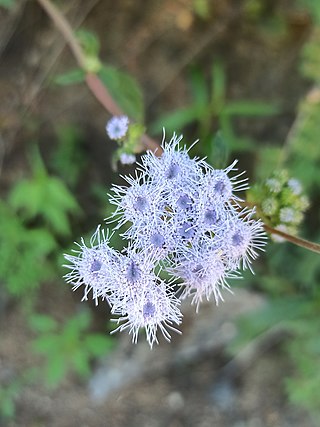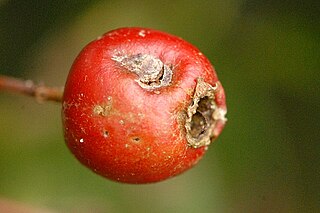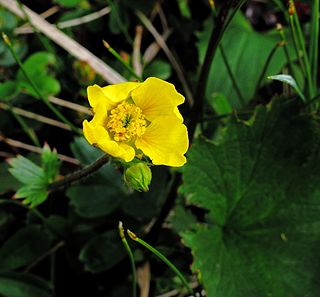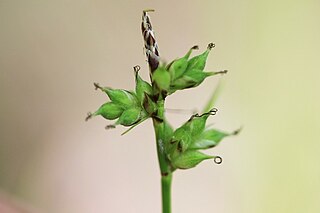
Ageratum is a genus of 40 to 60 tropical and warm temperate flowering annuals and perennials from the family Asteraceae, tribe Eupatorieae. Most species are native to Central America and Mexico but four are native to the United States.

The Venturiaceae are a family of fungi in the order Venturiales. Several of the species in this family are plant pathogens.

Hydnellum peckii is a fungus in the genus Hydnellum of the family Bankeraceae. It is a hydnoid species, producing spores on the surface of vertical spines or tooth-like projections that hang from the undersurface of the fruit bodies. It is found in North America, Europe, and was recently discovered in Iran (2008) and Korea (2010). Hydnellum peckii is a mycorrhizal species, and forms mutually beneficial relationships with a variety of coniferous trees, growing on the ground singly, scattered, or in fused masses.

Pleosporaceae is a family of sac fungi. They are pathogenic to humans or saprobic on woody and dead herbaceous stems or leaves.

Hydnellum is a genus of tooth fungi in the family Bankeraceae. Widely distributed in the Northern Hemisphere, the genus contains around 40 species. The fruitbodies of its members grow by slowly enveloping nearby bits of grass and vegetation. There is great variability in the form of Hydnellum fruitbodies, which are greatly influenced by environmental conditions such as rainfall and humidity, drying winds, and temperature. They are too tough and woody to eat comfortably. Several species have become the focus of increasing conservation concern following widespread declines in abundance.
Howard Elson Bigelow was an American mycologist, born in 1923 in Greenfield, Massachusetts, and died in 1987. He studied at Oberlin College from 1941 to 1943. He left college to fight in the American army. He returned to Oberlin after the war and obtained his Bachelor of Arts in 1949 and his Master of Arts in 1951. He studied botany at the University of Michigan under the guidance of Alexander Hanchett Smith (1904–1986) and received his doctorate in 1956. He was wed to mycologist Margaret Elizabeth Barr-Bigelow in 1956. Bigelow and his wife worked for University of Massachusetts from 1957 to his death. He is the author of works on the fungi of the genus Clitocybe and the family Tricholomataceae.
Jobellisia is a genus of fungi within the monotypic family Jobellisiaceae and the monotypic order Jobellisiales and also the subclass Hypocreomycetidae, and class Sordariomycetes. The genus was circumscribed by Margaret Elizabeth Barr-Bigelow in 1993 with Jobellisia luteola as the type species. It contains species that grow on dead wood and bark in tropical and temperate regions of the Northern Hemisphere.
Heinrich Simon Ludwig Friedrich Felix Rehm was a German mycologist and lichenologist. He studied at the Universities of Erlangen, Munich and Heidelberg, earning his medical doctorate in 1852. During his career, he was a practicing physician in Dietenhofen, Sugenheim, and Windsheim. In 1875, he became regional medical examiner in Lohr am Main.

Xenos is a genus of insects belonging to the family Xenidae. The word derives from the Greek word for strange. A species of the genus is Xenos vesparum, first described by Pietro Rossi in 1793. The females are permanent entomophagous endoparasites of Polistes paper wasps. They dwell their whole lives in the abdomens of wasps.

Geum peckii is a species of herbaceous, perennial flowering plant in the rose family known by the common name mountain avens. It is native to eastern North America, where it is known from only two locations, the White Mountains of New Hampshire and three sites in Nova Scotia.
Butyriboletus peckii is a fungus of the genus Butyriboletus native to eastern North America. It was first described by Charles Christopher Frost in 1878. Until 2014, it was known as Boletus peckii. Recent changes in the phylogenetic framework of the Boletaceae prompted the transfer of this species, along with several other related boletes, including Caloboletus calopus, to the genus Caloboletus. In 2015, Kuan Zhao and colleagues published analysis that demonstrated that the bolete belongs to Butyriboletus, closely related to Butyriboletus pulchriceps.

Butyriboletus is a genus of fungi in the family Boletaceae. The genus was circumscribed in 2014 by mycologists David Arora and Jonathan L. Frank to accommodate "butter bolete" species that were shown by molecular analysis to be phylogenetically distinct from Boletus. Butyriboletus contains 24 ectomycorrhizal species found in Asia, Europe, North America and north Africa.

Caloboletus is a fungal genus in the family Boletaceae. It was circumscribed by Italian mycologist Alfredo Vizzini with Caloboletus calopus as the type species. The erection of Caloboletus follows recent molecular studies that outlined a new phylogenetic framework for the Boletaceae. Boletus peckii was also transferred to this genus by Vizzini, but was subsequently moved to the genus Butyriboletus based on molecular evidence. The generic name Caloboletus, derived from the Greek calos "nice", refers to the attractive red coloring of the stipe.
Gorilline gammaherpesvirus 1 (GoHV-1), commonly known as herpesvirus gorilla is a species of virus in the genus Lymphocryptovirus, subfamily Gammaherpesvirinae, family Herpesviridae, and order Herpesvirales.
Pongine gammaherpesvirus 2 (PoHV-2), commonly known as orangutan herpesvirus, is a species of virus in the genus Lymphocryptovirus, subfamily Gammaherpesvirinae, family Herpesviridae, and order Herpesvirales.

Carex peckii, Peck's sedge, Peck's oak sedge, or white-tinged sedge, is a species of sedge native to Canada and the United States.
Delphinella polyspora is a species of fungus in the family Dothioraceae. It is known to grow on the pedicels and fruit of Kalmia procumbens and on Rhododendron indicum.
Delphinella is a genus of fungi belonging to the family Dothioraceae.
Delphinella balsameae is a species of fungus in the family Dothioraceae. It is a known plant pathogen, reported to cause blight in Siberian fir in Russia, balsam fir, white fir and subalpine fir in North-America.








